Here is a menu to quickly navigate through the post.
- What is a Strategy Map?
- Strategy Mapping Steps
- Principles of Developing a Strategy Map
- Why Should an Organization Develop a Strategy Map?
- How Can Strategy Mapping Help Organizations or Teams?
- How to Create a Strategy Map
- How Do You Align Individual Team Goals with an Organization’s Strategy Using a Strategy Map?
What is a Strategy Map?
A strategy map is a powerful strategic planning method that helps visualize the entire strategy of an organization on a single sheet of paper. It shows the cause-and-effect relationship between the components of an organizational strategy.
When it comes to strategy development, strategy maps have taken up a popular role in organizations. It’s a tool that promotes thinking, conversation as well as communication.
Diagrams – instead of the same old PowerPoint presentations and documents with too many pages – have proven to be a great language that organizations can use to communicate its strategies, direction, and priorities. They are not only easier to understand but also open up opportunities for everyone in the organization, from top to bottom, to get more involved during the design process.
Strategy Mapping Steps
- Defining Mission and Vision
- Understanding Your Environment
- Defining the Strategy
- Translating the Strategy
- Highlighting the Cause and Effect Relationships
- Showing Themes in Your Strategy Map
- Cascading the Strategy Map
Throughout the post, we have added strategy map templates, and you can use them to get a headstart on designing your strategy map.
Before we jump into creating a solid strategy map, let’s clarify what it is first. A diagram speaks a thousand words, so here’s a strategy map example for you to understand what it is.
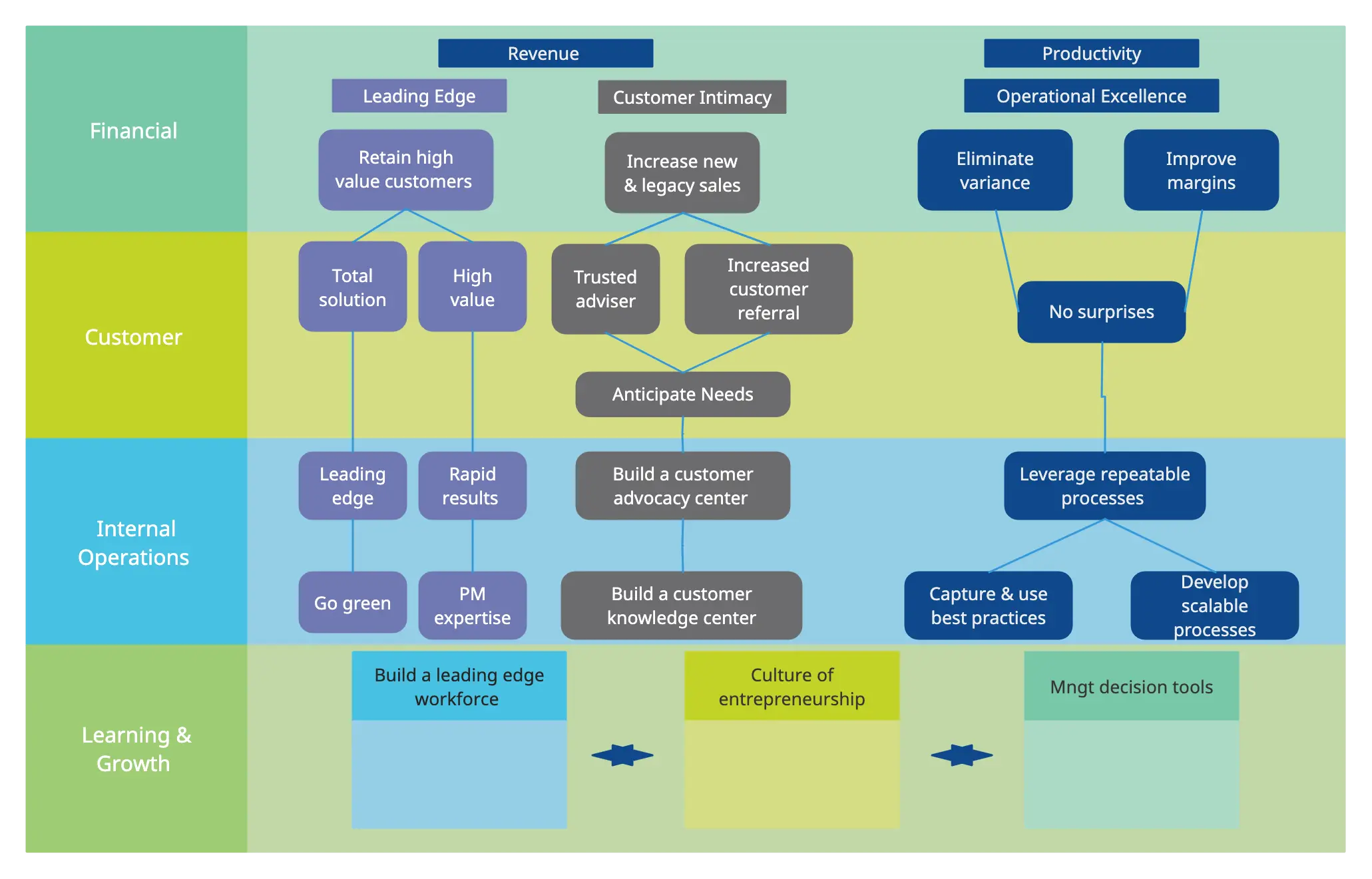
A strategy map is a powerful strategic planning method that helps visualize the entire strategy of an organization on a single sheet of paper. It shows the cause-and-effect relationship between the components of an organizational strategy.
The technique of strategy mapping is designed to help a management team explore and discuss the strategy in more detail than they normally would.
It helps develop highly effective strategies that can actually be implemented. In addition, strategy maps help those who are involved to develop the mission, vision, and goals, and action plans to address them, as well as understand the challenges they may face during the journey.
Strategy maps also help
- Discover strategic issues that are not necessarily obvious
- Be effective in evaluating organizational vision, mission, goals, strategies, and actions
- Communicate strategies in an easy-to-understand manner making it easier to implement them
- A way to properly guide, monitor, manage and review strategy implementation
- Stimulate thinking and facilitate conversation and understanding of the strategy
A generic strategy map focuses on four strategic perspectives;
- Financial perspective: outlines the tangible outcomes of the organizational strategy
- Customer perspective: describes the value proposition for the customers
- Internal process perspective: specifies the essential internal processes that will have the greatest impact on the strategy
- Learning and growth perspective: identifies the intangible assets important to the strategy
These elements are categorized as individual rows on the map, and each represents objectives pertaining to them. And the objectives are linked together to convey the cause-and-effect relationship between them.
The book “Strategy Maps” by veteran business consultants Robert Kaplan and David Norton popularized the idea of the technique, which emerged from years of research and client consultation conducted by them. The strategy map evolved from the four-perspective model of the balanced scorecard, which is another framework developed by the duo earlier.
Principles of Developing a Strategy Map
- Strategy balances contradictory forces
- Strategy is based on a differentiated value proposition
- Strategy consists of simultaneous, complementary themes
- Strategic alignment determines the value of intangible assets
To understand these principles in more detail refer to Strategy Maps: Converting Intangible Assets into Tangible Outcomes By Robert S. Kaplan, and David P. Norton.
Why Should an Organization Develop a Strategy Map?
Now that we have learned about what a strategy map is, let’s take a look at Now that we have learned what a strategy map is let’s look at why an organization should invest in developing a strategy map.
- A strategy map can help to get a clearer understanding of the organization’s strategic goals. It also helps ensure everyone understands the overall direction and is aligned toward achieving the same goals.
- A strategy map can help an organization to make better decisions by providing a framework for evaluating different perspectives. It can ensure that decisions are aligned with the overall strategic objectives and contribute to the movement of the objectives.
- A strategy map can improve resource allocation. It can help an organization to allocate resources effectively by identifying key drivers of success and focusing resources on such areas. The strategy map can also identify resources that may be over-allocated or under-allocated, allowing room for adjustments.
- A strategy map can improve communications. It can help to communicate the organization’s strategic goals and objectives to employees, customers, investors, partners, and other stakeholders. This will build understanding and support for the organization’s strategy, leading to improved performance and results.
How Can Strategy Mapping Help Organizations or Teams?
Strategy maps help organizations and teams align their objectives, initiatives, and measures with their strategic goals. It can help organizations and teams to,
- Clarify an organization’s or team’s objectives and how they relate to each other. The strategy map can provide a clear picture of what your organization or team is trying to achieve, how they will do it, and the resources needed.
- Ensure that all goals align with the organization’s or team’s overall strategic objectives. This will be useful in avoiding conflicting priorities and ensuring everyone is working towards the same goals.
- Improve communications to help stakeholders understand the organization’s or team’s strategic goals and how they can be achieved. This will also help build the buy-in and support of the stakeholders.
- Improve their focus on the most critical strategic objectives. A strategy map can help ensure that resources are allocated effectively and efficiently by highlighting the key drivers of success.
- Develop a set of key performance indicators (KPIs) aligned with the strategic objectives. This can help to measure progress and identify areas for improvement.
How to Create a Strategy Map
Most of the value the strategy provides to the organization comes from discussion and thinking generated during the process of designing it. Now that the strategy map definition is out of the way, let’s focus on the steps you need to take to create one.
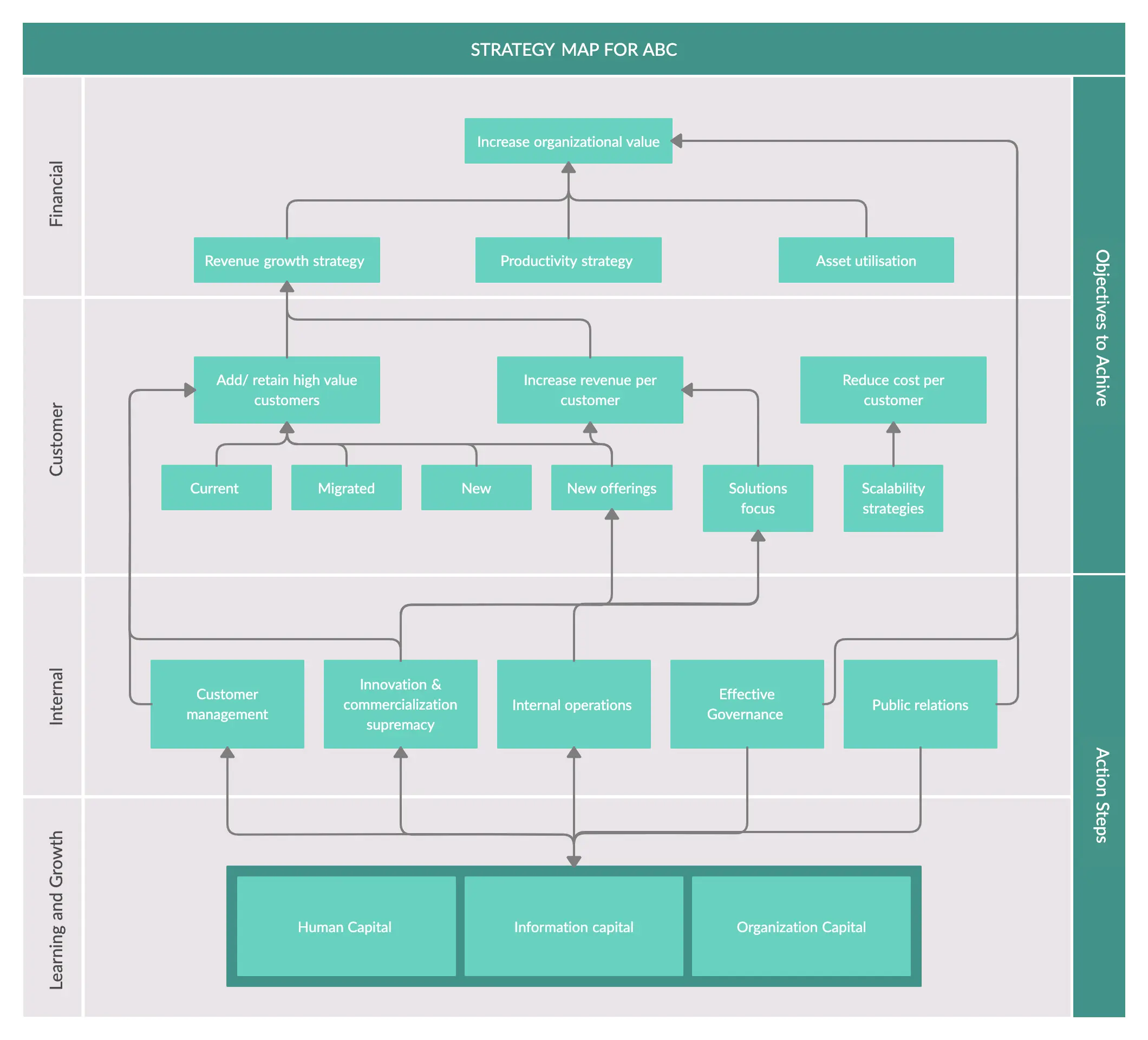
Step 1: Defining Mission and Vision
Most organizations already have mission and vision statements and values defined.
While the mission is an internally focused statement that describes why an organization exists and the purpose toward which its activities are directed, the vision statement (a more concise statement) outlines the short and long-term goals and objectives of the organization, creating a picture of its future.
The mission and the vision statements are crucial in helping the company stakeholders understand what the company is about and what it intends to achieve.
And having them well-defined will help you with the foundation for your strategy map.
Step 2: Understanding Your Environment
Before putting together your strategy, you need to understand the context; the landscape, and the industry in which your organization operates. Identifying the trends in the industry that may affect your strategy is equally important before you start mapping your strategy.
When analyzing the environment of your organization, one key aspect to focus on is the different stakeholders (customers, suppliers, competitors, investors, etc.) you interact with, what roles they play and what issues they may create.
A tool you can use here is the stakeholder map which will help identify everyone who has a stake or interest in your strategy and how they relate to the organization.
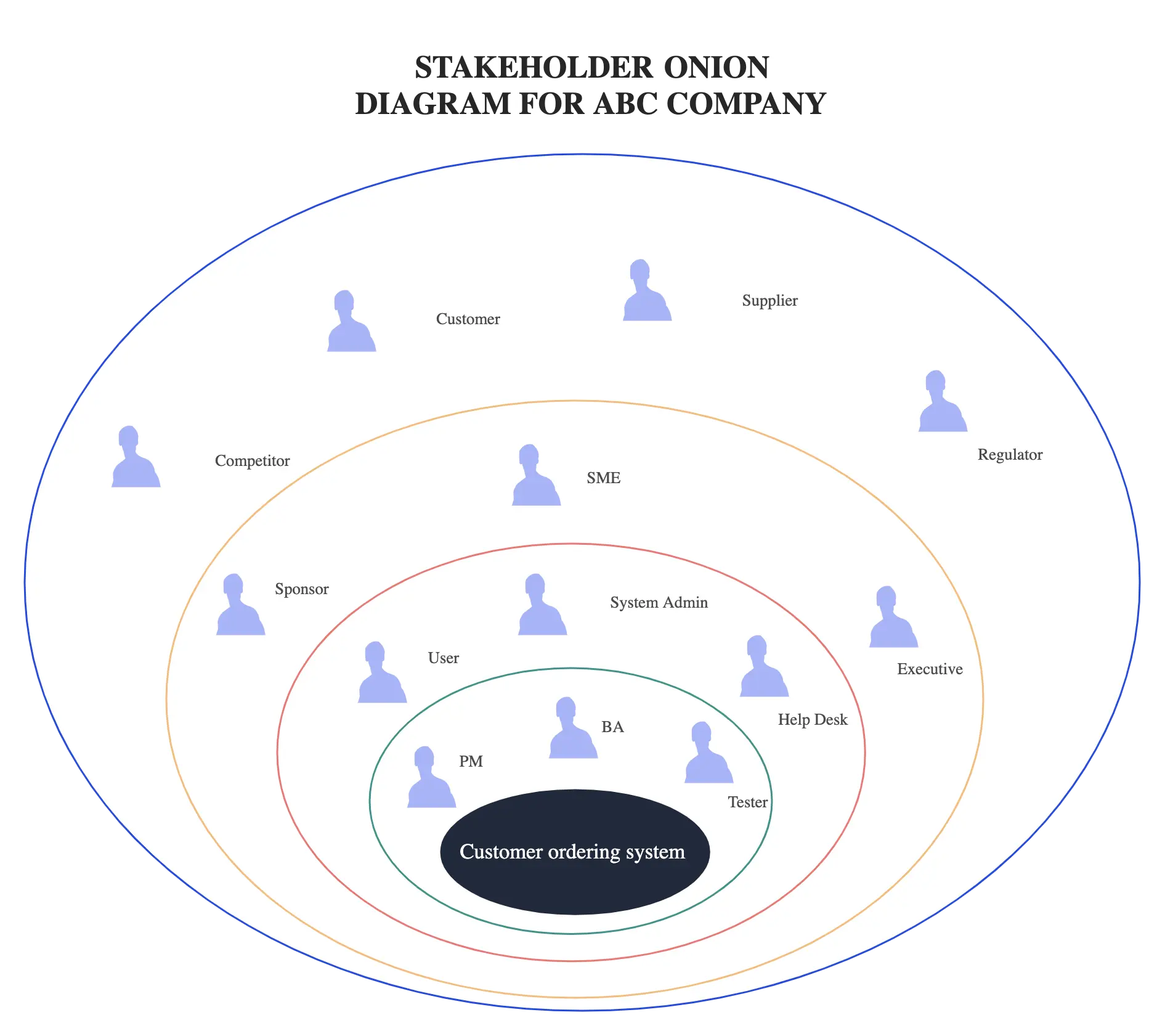
Another key aspect you need to focus on here is how you serve and add value to your customers and you can conduct a value chain analysis to understand this.
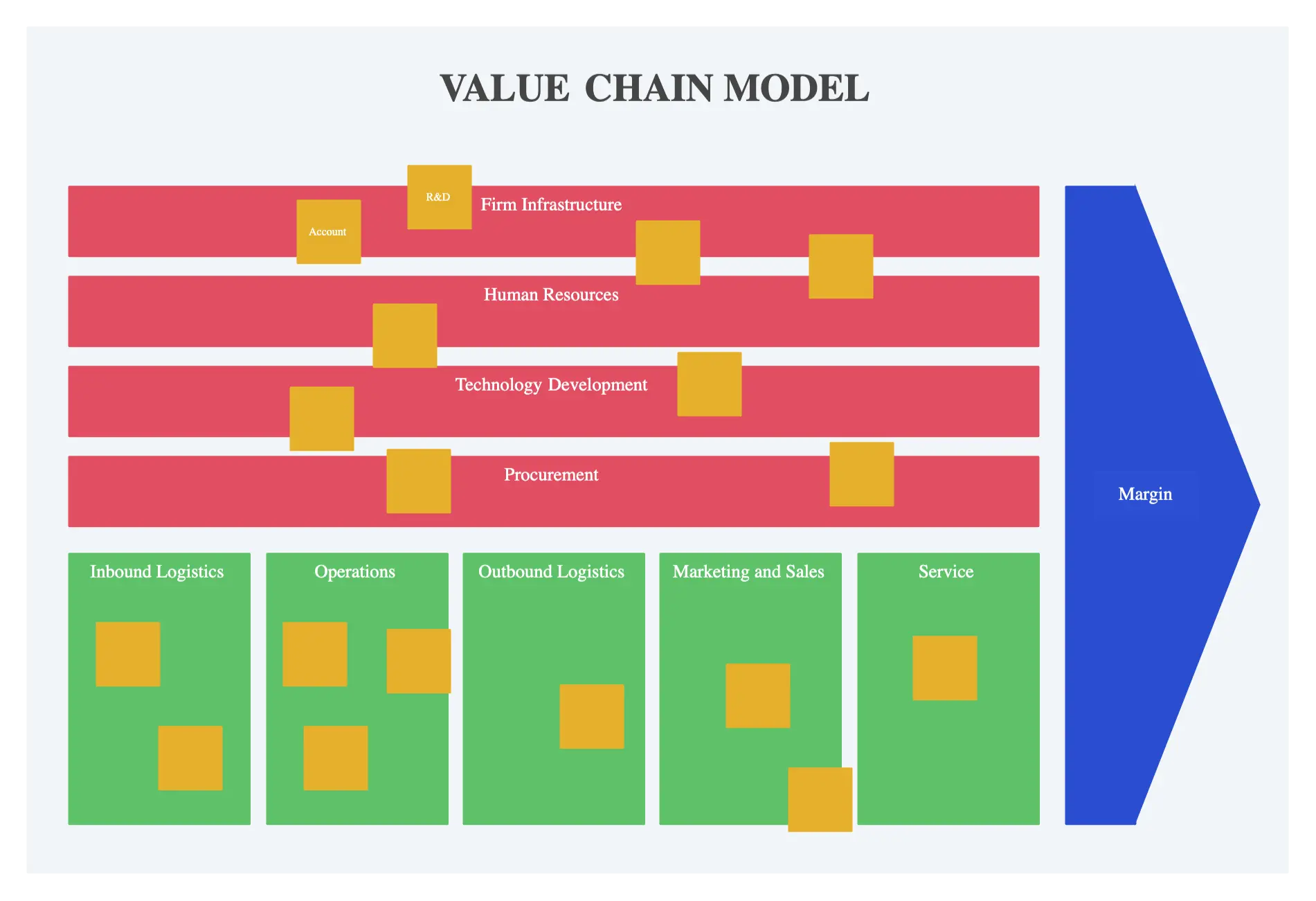
Through this stakeholder and value chain analysis, you will be able to identify the assumptions, issues, and risks that you may want to keep an eye out for as you implement your strategy.
Having completed this step will help you immensely when you are defining the customer perspective of the strategy map.
Step 3: Defining the Strategy
With an understanding of why the company exists, its general objectives and direction, and the environment in which your organization exists, you need to now focus on defining a strategy to accomplish the said mission and vision.
Your strategy describes the set of activities that you need to take to ensure that your organization will create a sustainable difference in the marketplace. For example, you can create a sustainable difference by offering a product that would deliver greater value to your customers than your competitors.
Step 4: Translating the Strategy
This is where the strategy map comes into play. It helps make your strategy seem more meaningful and actionable for your employees.
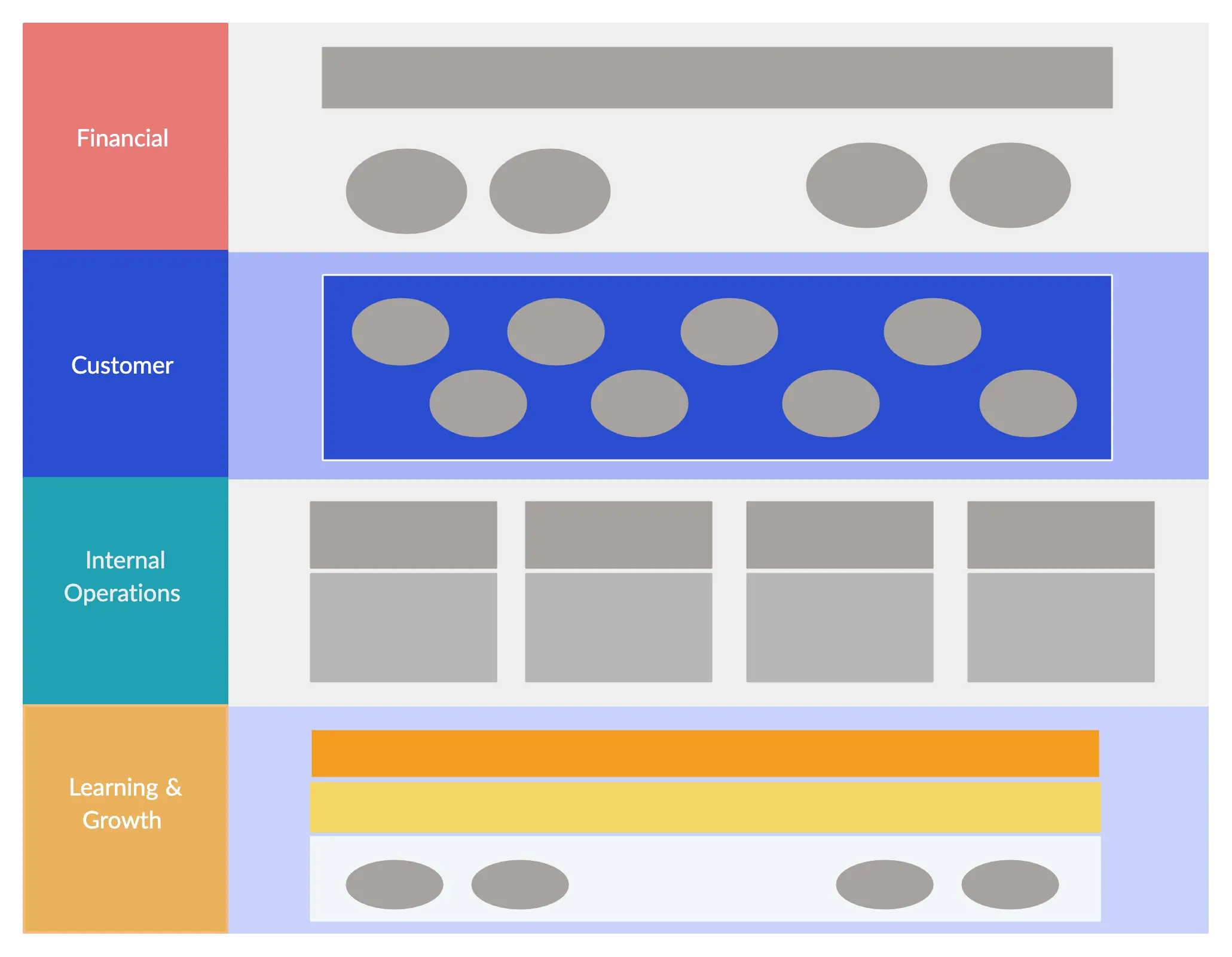
In a strategy map, the objectives in your balanced scorecard are represented with an oval shape. These objectives are then categorized under the four perspectives that we introduced earlier.
Financial Perspective
Specify the plans and strategies to improve revenue and lower costs. There are two dimensions to financial strategies – revenue growth (long-term objectives) and productivity (short-term objectives). The overarching financial objective of a strategy should be to sustain growth in shareholder value and therefore should comprise both short-term and long-term objectives.
For example, deepening relationships with existing customers to sell them more existing products or services or selling entirely new products is a common revenue growth strategy.
Productivity improvements can occur when companies reduce costs by lowering direct and indirect expenses which enables them to produce the same quantity of output while spending less on resources.
Customer Perspective
Understand who the targeted customers of the organization are in order to identify the objectives and measures for the value proposition it aims to offer them. The value proposition is based on the organization’s strategy for its customers. It communicates what the company expects to do for its customers better or differently than its competitors.
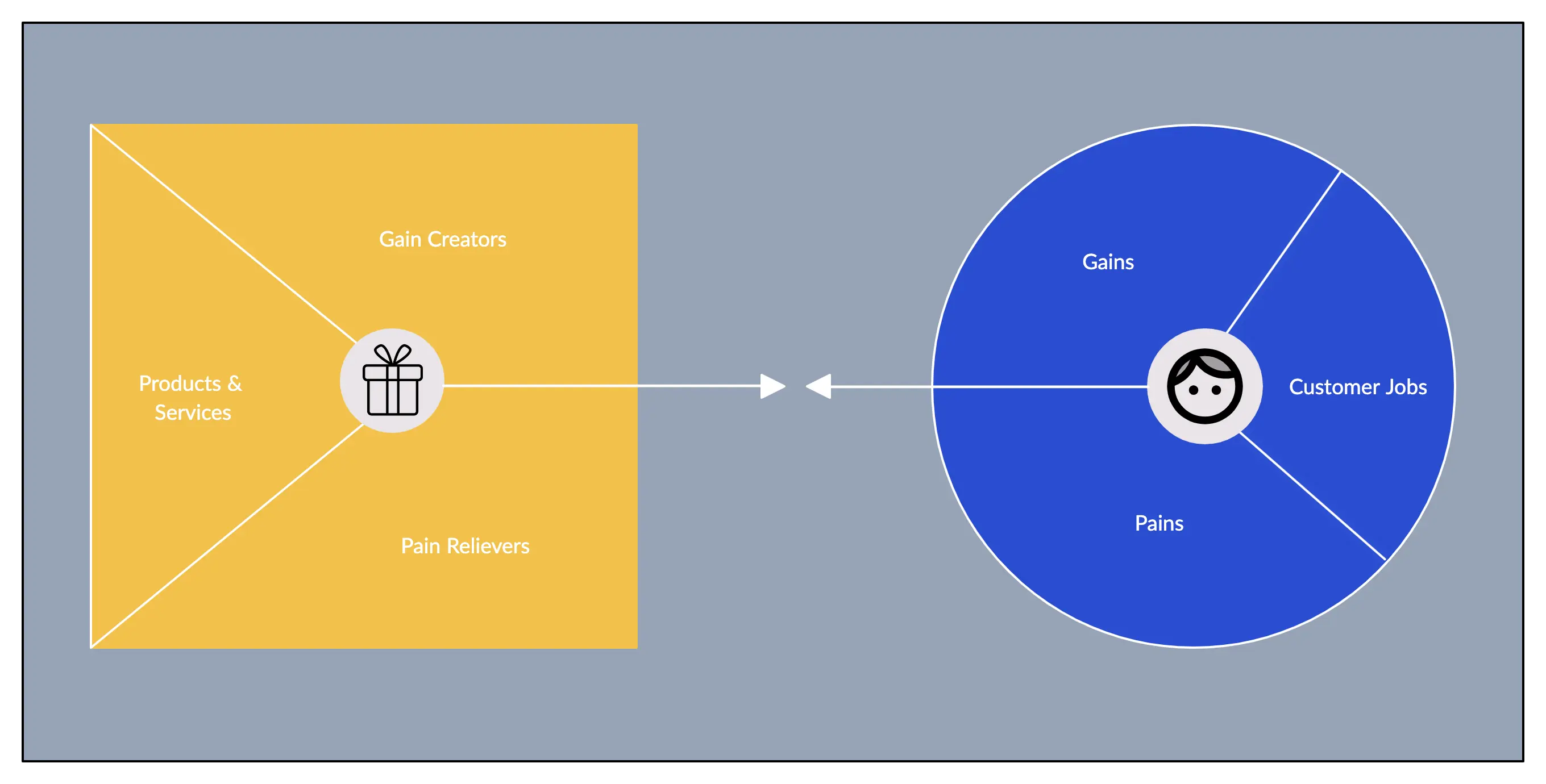
The objectives and measures for a particular value proposition define the strategy of an organization.
Internal Processes Perspective
How does the organization manage its internal processes and develop its human, information and organizational capital to deliver the differentiated value proposition of the strategy?
Internal processes help produce and deliver the value proposition for customers, and they help improve processes and reduce costs to boost productivity. Internal processes include operations management processes, customer management processes, innovation processes, and regulatory and social processes.
Learning and Growth Perspective
This section of the map focuses on the skills, knowledge, and systems the organization needs to deliver the intended value.
Step 5: Highlighting the Cause and Effect Relationships
Now that you have identified each of the objectives you need to complete in order to deliver your strategy, it’s time to show how the objectives are connected to each other. Draw arrows between objectives in each perspective to show this causal relationship.
For example, if you train your employees well enough, they will contribute to streamlining internal processes. And that’s a cause-and-effect relationship right there.
Step 6: Showing Themes in Your Strategy Map
Some organizations prefer to highlight themes in the strategy maps by vertically grouping objectives. Themes highlight strategic focuses, and they may represent areas such as sustainability, the culture of safety, etc.
Step 7: Cascading the Strategy Map
Corporate-level strategy maps are great at communicating the core strategies to key stakeholders, and most strategy mapping exercises tend to stop at this point of ‘corporate strategy map’.
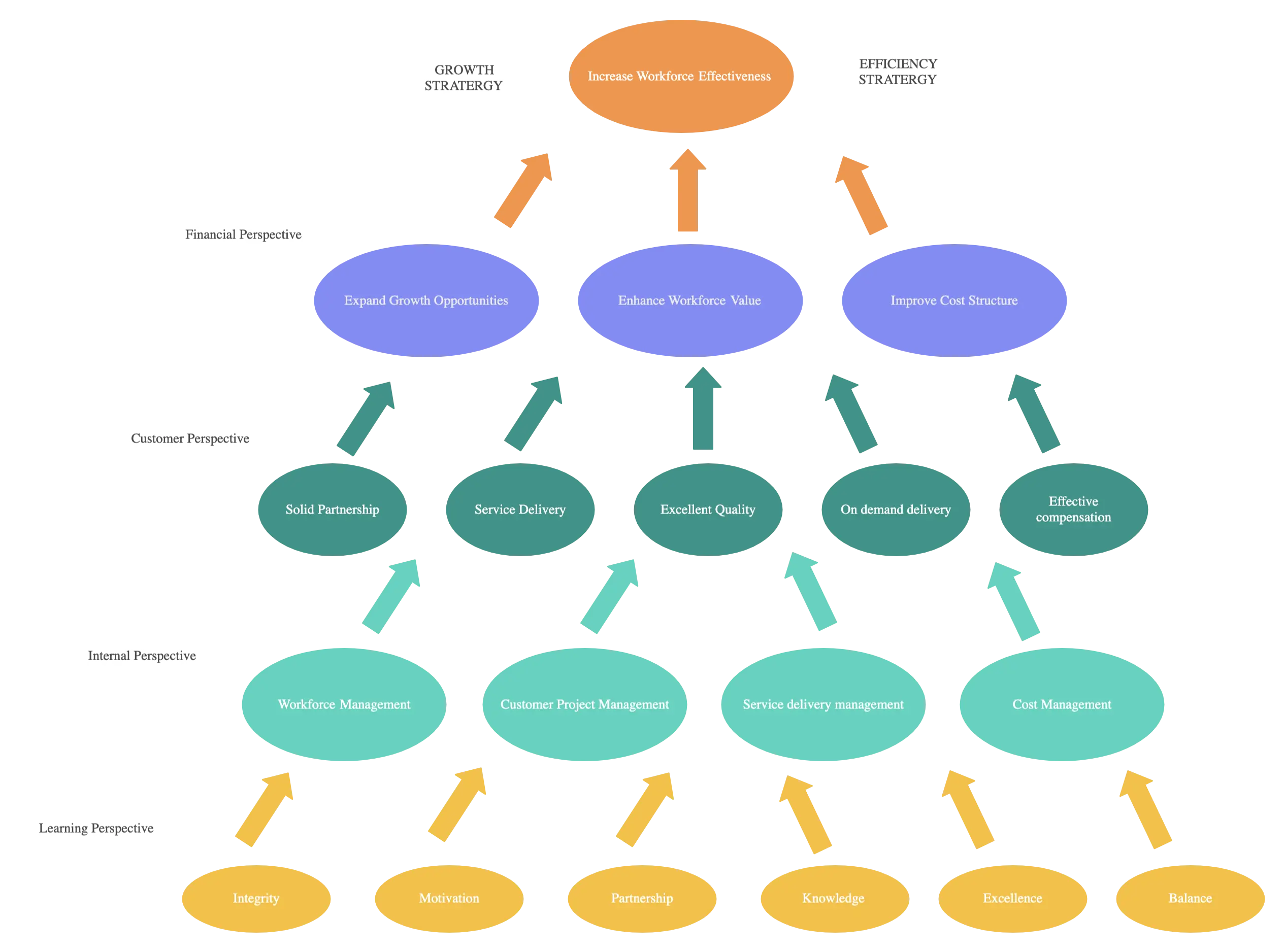
But the corporate strategy maps can be used as a starting point to develop many lower-level strategy maps. Such examples of cascading strategy maps include the within organization strategy maps (based on geographical, product, service, etc. distinctions), within perspective strategy maps, etc.
How Do You Align Individual Team Goals with an Organization’s Strategy Using a Strategy Map?
The key to aligning team goals with an organization’s strategy is to wait until the overall strategy map of the organization has been developed. Once that is done, each team can develop their own strategy maps that align with the organization’s overall strategy. A few essential tips to follow are to
- Break down the organization’s overall strategy map into smaller, more specific goals and objectives that can be assigned to different teams.
- Develop specific initiatives and action plans that support each team’s goals and objectives, ensuring they are aligned with the organization’s overall strategy.
- Identify key performance indicators (KPIs) that can measure progress towards each team’s goals and objectives and ensure they align with the organization’s overall KPIs.
- Establish clear roles and responsibilities for team members that support the team’s goals and objectives, including specific tasks and responsibilities needed to achieve the goals and objectives.
Time to Make Your Own Strategy Map
Your strategy map should describe how your organization’s values will affect the way you learn and grow to improve your internal processes, increase customer satisfaction and accomplish your financial goals in order to achieve your organization’s purpose and ambitions.
A correct, well-designed strategy map will make it easier to create the subsequent balance scorecard. It will also make communicating your strategy to the rest of the organization much easier.
FAQs About Strategy Maps
- A clear statement of the organization’s overall strategic objectives
- A set of strategic themes or perspectives (such as financial, customer, internal processes, and learning and growth)
- A set of specific strategic objectives and measures for each perspective
- A set of strategic initiatives or projects that will help the organization achieve its objectives
- A system for monitoring and reporting progress toward achieving the goals and initiatives
- Ensure the strategy map aligns with the organization’s overall mission and objectives.
- Involve key stakeholders in the development of the strategy map.
- Develop specific and measurable objectives and initiatives aligned with the organization’s overall strategy.
- Establish clear roles and responsibilities for team members.
- Regularly review progress towards achieving the objectives and initiatives and adjust the strategy map as necessary.
- Ensuring the buy-in and engagement of all stakeholders
- Balancing short-term and long-term objectives
- Aligning individual team goals with the organization’s overall strategy
- Collecting and using data effectively to measure progress
To overcome these challenges, make sure to
- Involve all stakeholders in the development of the strategy map
- Develop objectives and initiatives that balance short and long-term needs
- Develop specific initiatives and KPIs for individual teams that align with the overall strategy
- Invest in data collection





